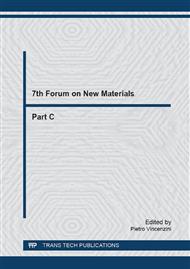[1]
H. Ichiura, T. Kitaoka and H. Tanaka, Removal of indoor pollutants under UV irradiation by a composite TiO2-zeolite sheet prepared using a papermaking technique, Chemosphere, 50 (2003) 79-83.
DOI: 10.1016/s0045-6535(02)00604-5
Google Scholar
[2]
S. Fukahori, H. Ichiura, T. Kitaoka and H. Tanaka, Capturing of bisphenol A photodecomposition intermediates by composite TiO2-zeolite sheets, Applied Catalysis B: Environmental 46 (2003) 453-462.
DOI: 10.1016/s0926-3373(03)00270-4
Google Scholar
[3]
P. C. Maness, S. Smolinski, D. M. Blake, Z. Huang, E. J. Wolfrum and W. A. Jacoby, Bactericidal activity of photocatalytic TiO2 reaction: toward an understanding of its killing mechanism, Applied and Environmental Microbiology 65 (1999) 4094-4098.
DOI: 10.1128/aem.65.9.4094-4098.1999
Google Scholar
[4]
J. W. Liou and H. H. Chang, Bacteri-cidal Effects and mechanisms of visible light-responsive titanium dioxide photocatalysts on pathogenic bacteria, Archivum Immunologiae et Therapiae Experimentalis 60 (2012) 267-275.
DOI: 10.1007/s00005-012-0178-x
Google Scholar
[5]
M. K. Nazeeruddin, F. De Angelis, S. Fantacci, A. Selloni, G. Viscardi, P. Liska, S. Ito, B. Takeru and M. Grätzel, Journal of the American Chemical Society 127 (2005) 16835-16847.
DOI: 10.1021/ja052467l
Google Scholar
[6]
A. Dutschke, C. Diegelmann and P. Lobmann, Preparation of TiO2 thin films on polystyrene by liquid phase deposition, Journal of Materials Chemistry 13 (2003) 1058-1063.
DOI: 10.1039/b212535h
Google Scholar
[7]
M. N. Tchoul, S. P. Fillery, H. Koerner, L. F. Drummy, F. T. Oyerokun, P. A. Mirau, M. F. Durstock and R. A. Vaia, Assemblies of titanium dioxide-polystyrene hybrid nanoparticles for dielectric applications, Chemistry of Materials 22 (2010).
DOI: 10.1021/cm903182n
Google Scholar
[8]
Q. Ye, X. Wang, H. Hu, D. Wang, S. Li and F. Zhou, Polyelectrolyte brush templated multiple loading of Pd nanoparticles onto TiO2 nanowires via regenerative counterion exchange− reduction, Journal of Physical Chemistry C 113 (2009) 7677-7683.
DOI: 10.1021/jp901301t
Google Scholar
[9]
A. Mesnage, M. Abdel Magied, P. Simon, N. Herlin-Boime, P. Jégou, G. Deniau and S. Palacin, Grafting polymers to titania nanoparticles by radical polymerization initiated by diazonium salt, Journal of Material Science 46 (2011) 6332-6338.
DOI: 10.1007/s10853-011-5709-z
Google Scholar
[10]
L. Xiong, H. Liang, R. Wang and L. Chen, A novel route for the synthesis of poly(2-hydroxyethyl methacrylate-co-methyl methacrylate) grafted titania nanoparticles via ATRP, Journal of Polymer Research 18 (2011) 1017-1021.
DOI: 10.1007/s10965-010-9502-5
Google Scholar
[11]
E. A. Smirnov, M. A. Meledina, A. V. Garshev, V. I. Chelpanov, S. Frost, J. U. Wieneke and M. Ulbricht, Grafting of titanium dioxide microspheres with a temperature-responsive polymer via surface-initiated atom transfer radical polymerization without the use of silane coupling agents, Polymer International 62 (2013).
DOI: 10.1002/pi.4377
Google Scholar


